DJ turn tables are the key tool used by club DJs. One of the best and most well known type of DJ turn tables is the Technics turntable. What is beat mixing using a Technics turn table?
When playing music off records being able to change the tempo of tracks is essential to keep the dance floor moving. One record's tempo can be changed to match the other and allow the rhythmical sections (I mean the drums) to overlap. This pitch adjustment of the records beats per minute (BPM, tempo) is possible on the legendary Technics turntables the SL1200 and SL1210.
What is the basic equipment I need? The basic equipment list in order to start practicing to mix is this:
2 x Turntables (get good direct drives like Technics turntables the SL1200/1210 or Vestax PDX 2000)
2 x SlipMats
2 x Needles for the Turntables
1 x Mixer
1 x Set of Headphones
A stereo system
What Turntables do most DJs use? The Technics SL1200 and SL1210 turntables are standard club DJ equipment around the world. Using powerful electromagnets (direct drive)to rotate the heavy platter mean that these turntables offer the best performance for DJ-ing and make beat mixing easier. All direct drive turntables offer better DJ performance than belt drive models.New DJs are always advised to get good direct drive turntables if they can afford it and buy a cheaper mixer instead. Once you get a set of these turntables you won't need to ever upgrade and can expect decades of reliable performance. I own a pair of Technics SL1210 turntables and haven't had a problem despite constantly carting them round to parties and clubs while gigging. Being a DJ is synonymous with playing music off records. In many ways being a skilled operator of Technics turntables IS being a skilled DJ. The next section will deal with the fundamental skill of dance music DJ-ing. Using turntables and beat mixing with them. Beat mixing: Beat mixing is using the pitch adjustment on your Technics turntable to match the tempo (BPM) of the next track with the one you are currently playing. Matching the tempo is done by listening to the next track through the headphones and comparing it to the track currently thumping the dance floor. The best way to compare is to start the next track in time with the current one and listen to see if the beats are getting ahead or slipping behind. If the track is too fast, slow it on the platter. If it is too slow, then speed it up by giving it a push round in the center of the record to keep the two tracks in time. Each of these adjustments should be accompanied by a small change in the pitch slider (faster or slower) so that the overall tempo of the tracks get closer.
What Turntables do most DJs use? The Technics SL1200 and SL1210 turntables are standard club DJ equipment around the world. Using powerful electromagnets (direct drive)to rotate the heavy platter mean that these turntables offer the best performance for DJ-ing and make beat mixing easier. All direct drive turntables offer better DJ performance than belt drive models.New DJs are always advised to get good direct drive turntables if they can afford it and buy a cheaper mixer instead. Once you get a set of these turntables you won't need to ever upgrade and can expect decades of reliable performance. I own a pair of Technics SL1210 turntables and haven't had a problem despite constantly carting them round to parties and clubs while gigging. Being a DJ is synonymous with playing music off records. In many ways being a skilled operator of Technics turntables IS being a skilled DJ. The next section will deal with the fundamental skill of dance music DJ-ing. Using turntables and beat mixing with them. Beat mixing: Beat mixing is using the pitch adjustment on your Technics turntable to match the tempo (BPM) of the next track with the one you are currently playing. Matching the tempo is done by listening to the next track through the headphones and comparing it to the track currently thumping the dance floor. The best way to compare is to start the next track in time with the current one and listen to see if the beats are getting ahead or slipping behind. If the track is too fast, slow it on the platter. If it is too slow, then speed it up by giving it a push round in the center of the record to keep the two tracks in time. Each of these adjustments should be accompanied by a small change in the pitch slider (faster or slower) so that the overall tempo of the tracks get closer.

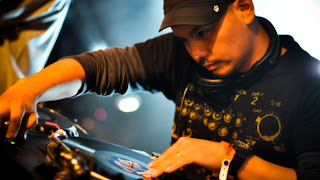
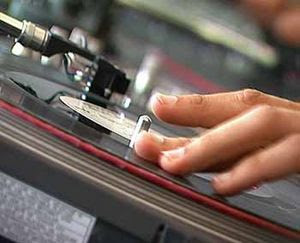
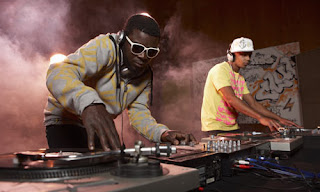
At first it is difficult to hear if the tracks are going out of time. If you get off your ass and do some practice then you can quickly train your ear to pick out the speed difference every time. Don't be discouraged at first if you can't hear any differences between the tracks. Just have a go, remember you have a 50% chance of getting it right. If you are a total novice then read on to the next section where I will explain beat mixing with turntables in more detail.
Basic beat mixing in detail, using your Technics turntables properly:
The best way to learn beat mixing from the beginning is to try to get two identical records. Two identical records won't go out of time if the pitch is set the same. If you don't have two the same try listening carefully to some of your tracks and pick two that have clear rhythmical sounds. This would mean a big bass kick sound at the start of a bar and clear snare sounds or high hat sounds marking the other beats in the bar. You should also try to select tracks that start straight into beats and not strings and other ambient sounds.
How to do your first mix step by step:
To start, first set one record to play and "cue" the next record up. Make sure the cross-fader is over to the side that has the playing track so that no sound comes out of the speakers from the cue channel. Cue the new track by putting the needle at the start of the record at letting it play before stopping it at the first sound. (this cue channel should be coming out of your headphones).
The turntable platter should be rotating underneath the record now. Here is a picture showing you how to hold the track ready to drop.
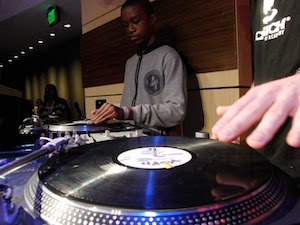
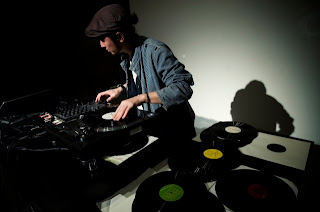
This first sound you grab like this should be the first beat of the first bar of the track. You should hold this beat so that the sound in the groove (in the vinyl) is underneath the needle and when you move your hand the beat sounds slowly through your headphones.
The tricky part now is to start this beat at the same time as first beat of the bar of the currently playing track. If you do this correctly the beats should overlap as both tracks play. Dropping a cue track in time with the track playing out is not easy and does require some practice to get the hang of. Remember, tracks that have different tempos once started will drift out of time with the beats getting less crisp. This means that when you are starting out take your time isten carefully ... did you hear the kick or snare in your headphone first or was it slightly behind? Imagine the diagram above and get a mental picture of how the beats relate to one another.
If the cue track is getting behind speed it up by giving the record a push round the middle like this. When you are adjusting the pitch to match tempos speed up or slow the record down with your left hand and keep your right hand on the pitch adjustment slider.
To slow the cue track down, gently slow the platter by touching the side like this. Remember to adjust the overall tempo using the turntables pitch adjustment after you make these changes. This means that the 2 tempos should get closer and closer together. When 2 tracks are closely matched they will take a while before they get out of time.
The key thing is to train your ear to recognize the slight difference in timing of the beat between the track playing out and the cue rack in your headphone. A good trick to help you do this is to pick a beat to compare - say the 1st beat (in a bar) for both tracks and listen in each bar for this beat only. You'll be trying to hear if the beat in one track is hitting before the other.

No comments:
Post a Comment